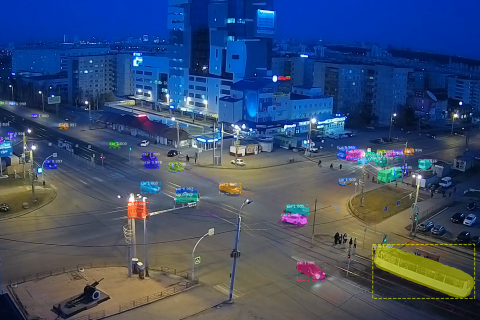Scientists of South Ural State University, within the framework of the national technology initiative AutoNet (the Smart Transport project), have developed a unique intelligent system for monitoring traffic flows using artificial intelligence, which does not require specific recording equipment and can work on almost any type of camera. It is equally important that the system allows you to instantly process data received in real-time, unlike existing programs, where processing is carried out with a delay of up to 10-15 minutes. An article on the results of the study was published in the highly-rated scientific journal “Journal of Big Data” (included in the TOP 10 of Scopus scientometric database).
Traffic Jam Solution
Digitalization is the most necessary condition for the formation of modern transport infrastructure. For high-quality traffic management and efficient use of the road network in the context of the infrastructural restrictions of cities, transport services need powerful tools for traffic analysis. Scientists at South Ural State University have developed an innovative technology for the intelligent analysis of traffic based on a multi-component system for dynamic traffic monitoring using neural networks. At one time, they went beyond the classical methods of Data Mining.
“We have proposed and implemented a modernized system for assessing traffic flows, based on the most recent advances in the detection and tracking of vehicles. Unlike existing analogs, our system recognizes and analyzes in real-time the direction of movement of vehicles with a maximum relative error of less than 10%. The closest analogs are able to determine the speed and classify vehicles in only one direction and with the condition of placing the cameras above the traffic flow with an accuracy of 80-90%. Operating a neural network allows you to generate up to 400 traffic parameters in real-time at each intersection. The unique AIMS monitoring system developed by SUSU scientists collects, interprets and transmits data on the intensity of road traffic, classifies 10 categories of vehicles, measures speed, the current load level of each direction of the intersection, determines the further direction of vehicles. At the same time, real-time object recognition at the sheer intersection AIMS produces through the use of only one Full HD CCTV camera.The results of this study can be operated by city authorities to improve the overall traffic capacity of the intersection. We have already proved our system at several intersections in Chelyabinsk to verify that the proposed solution is sufficiently accurate and can be used as a basis for other high-level models,” mentions project manager Vladimir Shepelev, associate professor at the Automotive Transport Department of the Polytechnic Institute SUSU.
The innovative technology allows you to receive data on the structure of the traffic flow, vehicle directions and speeds in real-time. Using data mining technology will support implementation of efficient traffic patterns, reduce traffic congestion and improve resource management.
.jpg)
Neural networks for the urban traffic analysis
The current practice of monitoring traffic frequently relies on the use of expensive sensors for continuous data collection or on a visual study of traffic, usually measured over several days over certain periods of time. However, transport services do not receive proper and accurate information on the structure of the traffic flow, its intensity, speed, and in the following direction of movement.
“We managed neural networks to process massive amounts of video data, not only for detecting and tracking vehicles but also for analyzing the sequence of events,” continues a SUSU scientist. “In the process of developing the technology, we used the open-source Mask R-CNN and YOLOv3 neural network architectures to detect objects in real-time, as well as the SORT tracker, the code of which was modified by the team to improve the quality of object tracking.”
The embedded analytic block based on artificial intelligence determines the level of traffic organization at the intersection and assigns KPI to each direction of movement.
.jpg)
Increased efficiency and lowering monitoring costs
As a result of optimization of the YOLOv3 neural network algorithms, SUSU scientists were able to achieve accuracy of the data obtained at the level of 95%, taking into account the loss of objects during tracking, and significantly reduce the cost of real-time monitoring equipment.
“Artificial intelligence with machine vision takes data collection and analysis of road traffic to a new level, making it possible to recognize vehicles with much greater reliability than ever before,” says Vladimir Shepelev. “Our deep learning networks are easy to configure, do not require specific recording equipment and can work on almost any type of camera.”
The technology developed by scientists of the South Ural State University will increase the efficiency of using urban road infrastructure. In the near future, technology for monitoring road traffic using artificial intelligence will become part of the Sustainable Public Transport project for the city of Chelyabinsk.




